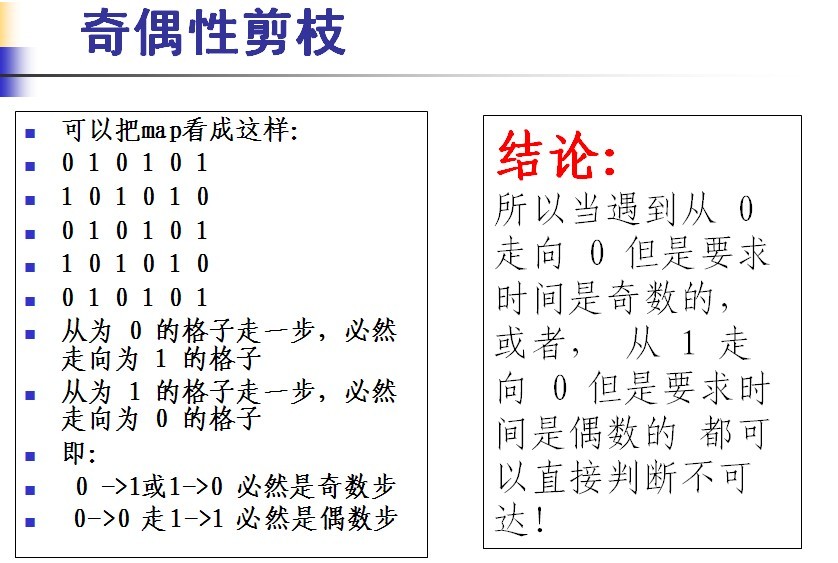Problem Description
The doggie found a bone in an ancient maze, which fascinated him a lot. However, when he picked it up, the maze began to shake, and the doggie could feel the ground sinking. He realized that the bone was a trap, and he tried desperately to get out of this maze.
The maze was a rectangle with sizes N by M. There was a door in the maze. At the beginning, the door was closed and it would open at the T-th second for a short period of time (less than 1 second). Therefore the doggie had to arrive at the door on exactly the T-th second. In every second, he could move one block to one of the upper, lower, left and right neighboring blocks. Once he entered a block, the ground of this block would start to sink and disappear in the next second. He could not stay at one block for more than one second, nor could he move into a visited block. Can the poor doggie survive? Please help him.
The maze was a rectangle with sizes N by M. There was a door in the maze. At the beginning, the door was closed and it would open at the T-th second for a short period of time (less than 1 second). Therefore the doggie had to arrive at the door on exactly the T-th second. In every second, he could move one block to one of the upper, lower, left and right neighboring blocks. Once he entered a block, the ground of this block would start to sink and disappear in the next second. He could not stay at one block for more than one second, nor could he move into a visited block. Can the poor doggie survive? Please help him.
Input
The input consists of multiple test cases. The first line of each test case contains three integers N, M, and T (1 < N, M < 7; 0 < T < 50), which denote the sizes of the maze and the time at which the door will open, respectively. The next N lines give the maze layout, with each line containing M characters. A character is one of the following:
'X': a block of wall, which the doggie cannot enter;
'S': the start point of the doggie;
'D': the Door; or
'.': an empty block.
The input is terminated with three 0's. This test case is not to be processed.
'X': a block of wall, which the doggie cannot enter;
'S': the start point of the doggie;
'D': the Door; or
'.': an empty block.
The input is terminated with three 0's. This test case is not to be processed.
Output
For each test case, print in one line "YES" if the doggie can survive, or "NO" otherwise.
Sample Input
4 4 5S.X...X...XD....3 4 5S.X...X....D0 0 0
Sample Output
NOYES
虽然是看完LCY老师的课件之后再按照其思路敲的
期间还错了几次,⊙﹏⊙b汗
先看下LCY老师说的奇偶性剪枝
再看这段代码
tem = t-cnt - s1 - s2;
其中t-cnt味剩余的步数或者说时间,另其为T
s1+s2为剩余步数,另其为S
如果走偶数步要求的时间是奇数,或者走奇数步要求的时间是偶数,都明显不可行
而轻易得出奇数-偶数 = 奇数,反之亦然
而奇数-奇数= 偶数,偶数-偶数=偶数
搜易tem必须为偶
理解了这里就没什么难的了
代码如下:
#include <stdio.h>#include <string.h>#include <math.h>int n,m,t;char map[10][10];int flag;int di,dj,wall;int to[4][2] = {{0,-1},{0,1},{-1,0},{1,0}};void dfs(int si,int sj,int cnt)//深搜{ int i,tem; if(si>n || sj>m || si<=0 || sj <= 0)//出界 return ; if(cnt == t && si == di && sj == dj)//到达终点 flag = 1; if(flag) return ; int s1 = si-di; int s2 = sj-dj; if(s1<0) s1=-s1; if(s2<0) s2=-s2; tem = t-cnt - s1 - s2; if(tem<0 || tem&1)//看剩下的时间能能否到达终点,tem&1则是判断其是否偶数,根据LCY的奇偶性剪枝可得tem必须是偶数,是奇数则不行 return; for(i = 0; i<4; i++) { if(map[si+to[i][0]][sj+to[i][1]]!='X') { map[si+to[i][0]][sj+to[i][1]]='X';//走过的地方变为墙 dfs(si+to[i][0],sj+to[i][1],cnt+1); map[si+to[i][0]][sj+to[i][1]]='.';//迷宫还原,以便下次广搜 } } return ;}int main(){ int i,j,si,sj; while(~scanf("%d%d%d%*c",&n,&m,&t)) { if(!n && !m && !t) break; wall = 0; for(i = 1; i<=n; i++) { for(j = 1; j<=m; j++) { scanf("%c",&map[i][j]); if(map[i][j] == 'S') { si = i; sj = j; } else if(map[i][j] == 'D') { di = i; dj = j; } else if(map[i][j] == 'X') wall++; } getchar(); } if(n*m-wall<=t)//t是代表要走的步数,步数加墙数必须小于总格子数的,因为所有格子中还包括了S和D,这是剪枝 { printf("NO\n"); continue; } flag = 0; map[si][sj] = 'X';//出发点是不可能再走的了,变为墙 dfs(si,sj,0); if(flag) printf("YES\n"); else printf("NO\n"); } return 0;}
